Michael Felsberg
R3D2: Realistic 3D Asset Insertion via Diffusion for Autonomous Driving Simulation
Jun 09, 2025Abstract:Validating autonomous driving (AD) systems requires diverse and safety-critical testing, making photorealistic virtual environments essential. Traditional simulation platforms, while controllable, are resource-intensive to scale and often suffer from a domain gap with real-world data. In contrast, neural reconstruction methods like 3D Gaussian Splatting (3DGS) offer a scalable solution for creating photorealistic digital twins of real-world driving scenes. However, they struggle with dynamic object manipulation and reusability as their per-scene optimization-based methodology tends to result in incomplete object models with integrated illumination effects. This paper introduces R3D2, a lightweight, one-step diffusion model designed to overcome these limitations and enable realistic insertion of complete 3D assets into existing scenes by generating plausible rendering effects-such as shadows and consistent lighting-in real time. This is achieved by training R3D2 on a novel dataset: 3DGS object assets are generated from in-the-wild AD data using an image-conditioned 3D generative model, and then synthetically placed into neural rendering-based virtual environments, allowing R3D2 to learn realistic integration. Quantitative and qualitative evaluations demonstrate that R3D2 significantly enhances the realism of inserted assets, enabling use-cases like text-to-3D asset insertion and cross-scene/dataset object transfer, allowing for true scalability in AD validation. To promote further research in scalable and realistic AD simulation, we will release our dataset and code, see https://research.zenseact.com/publications/R3D2/.
A Culturally-diverse Multilingual Multimodal Video Benchmark & Model
Jun 08, 2025Abstract:Large multimodal models (LMMs) have recently gained attention due to their effectiveness to understand and generate descriptions of visual content. Most existing LMMs are in English language. While few recent works explore multilingual image LMMs, to the best of our knowledge, moving beyond the English language for cultural and linguistic inclusivity is yet to be investigated in the context of video LMMs. In pursuit of more inclusive video LMMs, we introduce a multilingual Video LMM benchmark, named ViMUL-Bench, to evaluate Video LMMs across 14 languages, including both low- and high-resource languages: English, Chinese, Spanish, French, German, Hindi, Arabic, Russian, Bengali, Urdu, Sinhala, Tamil, Swedish, and Japanese. Our ViMUL-Bench is designed to rigorously test video LMMs across 15 categories including eight culturally diverse categories, ranging from lifestyles and festivals to foods and rituals and from local landmarks to prominent cultural personalities. ViMUL-Bench comprises both open-ended (short and long-form) and multiple-choice questions spanning various video durations (short, medium, and long) with 8k samples that are manually verified by native language speakers. In addition, we also introduce a machine translated multilingual video training set comprising 1.2 million samples and develop a simple multilingual video LMM, named ViMUL, that is shown to provide a better tradeoff between high-and low-resource languages for video understanding. We hope our ViMUL-Bench and multilingual video LMM along with a large-scale multilingual video training set will help ease future research in developing cultural and linguistic inclusive multilingual video LMMs. Our proposed benchmark, video LMM and training data will be publicly released at https://mbzuai-oryx.github.io/ViMUL/.
Model Stitching by Functional Latent Alignment
May 26, 2025Abstract:Evaluating functional similarity involves quantifying the degree to which independently trained neural networks learn functionally similar representations. Reliably inferring the functional similarity of these networks remains an open problem with far-reaching implications for AI. Model stitching has emerged as a promising paradigm, where an optimal affine transformation aligns two models to solve a task, with the stitched model serving as a proxy for functional similarity. In this work, we draw inspiration from the knowledge distillation literature and propose Functional Latent Alignment (FuLA) as a novel optimality condition for model stitching. We revisit previously explored functional similarity testbeds and introduce a new one, based on which FuLA emerges as an overall more reliable method of functional similarity. Specifically, our experiments in (a) adversarial training, (b) shortcut training and, (c) cross-layer stitching, reveal that FuLA is less prone to artifacts tied to training on task cues while achieving non-trivial alignments that are missed by stitch-level matching.
Efficient Motion Prompt Learning for Robust Visual Tracking
May 22, 2025Abstract:Due to the challenges of processing temporal information, most trackers depend solely on visual discriminability and overlook the unique temporal coherence of video data. In this paper, we propose a lightweight and plug-and-play motion prompt tracking method. It can be easily integrated into existing vision-based trackers to build a joint tracking framework leveraging both motion and vision cues, thereby achieving robust tracking through efficient prompt learning. A motion encoder with three different positional encodings is proposed to encode the long-term motion trajectory into the visual embedding space, while a fusion decoder and an adaptive weight mechanism are designed to dynamically fuse visual and motion features. We integrate our motion module into three different trackers with five models in total. Experiments on seven challenging tracking benchmarks demonstrate that the proposed motion module significantly improves the robustness of vision-based trackers, with minimal training costs and negligible speed sacrifice. Code is available at https://github.com/zj5559/Motion-Prompt-Tracking.
Interactive Double Deep Q-network: Integrating Human Interventions and Evaluative Predictions in Reinforcement Learning of Autonomous Driving
Apr 28, 2025Abstract:Integrating human expertise with machine learning is crucial for applications demanding high accuracy and safety, such as autonomous driving. This study introduces Interactive Double Deep Q-network (iDDQN), a Human-in-the-Loop (HITL) approach that enhances Reinforcement Learning (RL) by merging human insights directly into the RL training process, improving model performance. Our proposed iDDQN method modifies the Q-value update equation to integrate human and agent actions, establishing a collaborative approach for policy development. Additionally, we present an offline evaluative framework that simulates the agent's trajectory as if no human intervention had occurred, to assess the effectiveness of human interventions. Empirical results in simulated autonomous driving scenarios demonstrate that iDDQN outperforms established approaches, including Behavioral Cloning (BC), HG-DAgger, Deep Q-Learning from Demonstrations (DQfD), and vanilla DRL in leveraging human expertise for improving performance and adaptability.
From Missing Pieces to Masterpieces: Image Completion with Context-Adaptive Diffusion
Apr 19, 2025Abstract:Image completion is a challenging task, particularly when ensuring that generated content seamlessly integrates with existing parts of an image. While recent diffusion models have shown promise, they often struggle with maintaining coherence between known and unknown (missing) regions. This issue arises from the lack of explicit spatial and semantic alignment during the diffusion process, resulting in content that does not smoothly integrate with the original image. Additionally, diffusion models typically rely on global learned distributions rather than localized features, leading to inconsistencies between the generated and existing image parts. In this work, we propose ConFill, a novel framework that introduces a Context-Adaptive Discrepancy (CAD) model to ensure that intermediate distributions of known and unknown regions are closely aligned throughout the diffusion process. By incorporating CAD, our model progressively reduces discrepancies between generated and original images at each diffusion step, leading to contextually aligned completion. Moreover, ConFill uses a new Dynamic Sampling mechanism that adaptively increases the sampling rate in regions with high reconstruction complexity. This approach enables precise adjustments, enhancing detail and integration in restored areas. Extensive experiments demonstrate that ConFill outperforms current methods, setting a new benchmark in image completion.
GASP: Unifying Geometric and Semantic Self-Supervised Pre-training for Autonomous Driving
Mar 19, 2025Abstract:Self-supervised pre-training based on next-token prediction has enabled large language models to capture the underlying structure of text, and has led to unprecedented performance on a large array of tasks when applied at scale. Similarly, autonomous driving generates vast amounts of spatiotemporal data, alluding to the possibility of harnessing scale to learn the underlying geometric and semantic structure of the environment and its evolution over time. In this direction, we propose a geometric and semantic self-supervised pre-training method, GASP, that learns a unified representation by predicting, at any queried future point in spacetime, (1) general occupancy, capturing the evolving structure of the 3D scene; (2) ego occupancy, modeling the ego vehicle path through the environment; and (3) distilled high-level features from a vision foundation model. By modeling geometric and semantic 4D occupancy fields instead of raw sensor measurements, the model learns a structured, generalizable representation of the environment and its evolution through time. We validate GASP on multiple autonomous driving benchmarks, demonstrating significant improvements in semantic occupancy forecasting, online mapping, and ego trajectory prediction. Our results demonstrate that continuous 4D geometric and semantic occupancy prediction provides a scalable and effective pre-training paradigm for autonomous driving. For code and additional visualizations, see \href{https://research.zenseact.com/publications/gasp/.
DaD: Distilled Reinforcement Learning for Diverse Keypoint Detection
Mar 11, 2025Abstract:Keypoints are what enable Structure-from-Motion (SfM) systems to scale to thousands of images. However, designing a keypoint detection objective is a non-trivial task, as SfM is non-differentiable. Typically, an auxiliary objective involving a descriptor is optimized. This however induces a dependency on the descriptor, which is undesirable. In this paper we propose a fully self-supervised and descriptor-free objective for keypoint detection, through reinforcement learning. To ensure training does not degenerate, we leverage a balanced top-K sampling strategy. While this already produces competitive models, we find that two qualitatively different types of detectors emerge, which are only able to detect light and dark keypoints respectively. To remedy this, we train a third detector, DaD, that optimizes the Kullback-Leibler divergence of the pointwise maximum of both light and dark detectors. Our approach significantly improve upon SotA across a range of benchmarks. Code and model weights are publicly available at https://github.com/parskatt/dad
All Languages Matter: Evaluating LMMs on Culturally Diverse 100 Languages
Nov 25, 2024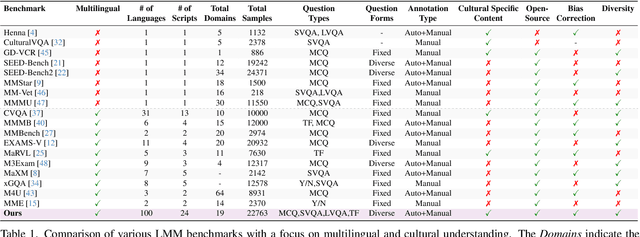
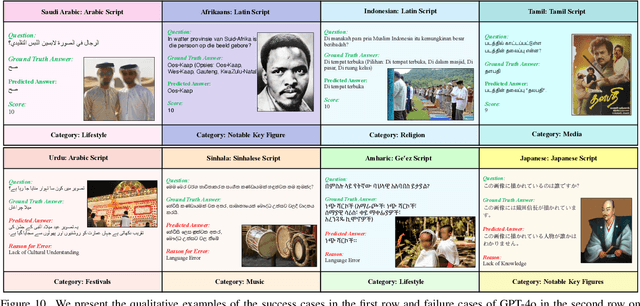
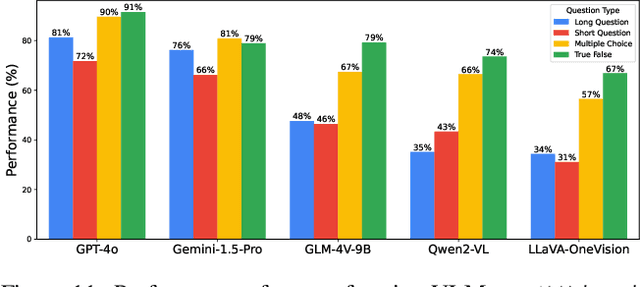

Abstract:Existing Large Multimodal Models (LMMs) generally focus on only a few regions and languages. As LMMs continue to improve, it is increasingly important to ensure they understand cultural contexts, respect local sensitivities, and support low-resource languages, all while effectively integrating corresponding visual cues. In pursuit of culturally diverse global multimodal models, our proposed All Languages Matter Benchmark (ALM-bench) represents the largest and most comprehensive effort to date for evaluating LMMs across 100 languages. ALM-bench challenges existing models by testing their ability to understand and reason about culturally diverse images paired with text in various languages, including many low-resource languages traditionally underrepresented in LMM research. The benchmark offers a robust and nuanced evaluation framework featuring various question formats, including true/false, multiple choice, and open-ended questions, which are further divided into short and long-answer categories. ALM-bench design ensures a comprehensive assessment of a model's ability to handle varied levels of difficulty in visual and linguistic reasoning. To capture the rich tapestry of global cultures, ALM-bench carefully curates content from 13 distinct cultural aspects, ranging from traditions and rituals to famous personalities and celebrations. Through this, ALM-bench not only provides a rigorous testing ground for state-of-the-art open and closed-source LMMs but also highlights the importance of cultural and linguistic inclusivity, encouraging the development of models that can serve diverse global populations effectively. Our benchmark is publicly available.
Affine steerers for structured keypoint description
Aug 26, 2024
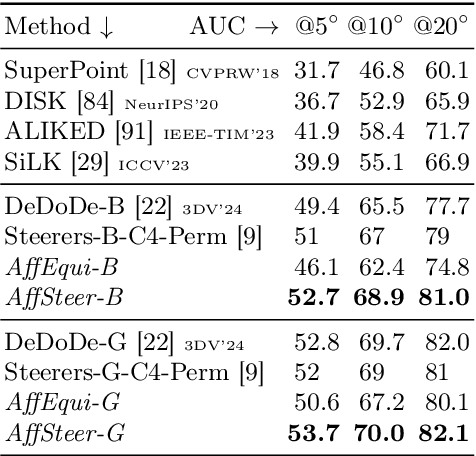
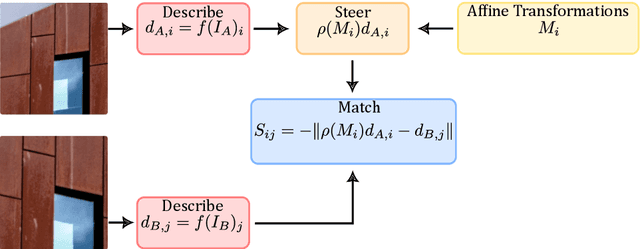
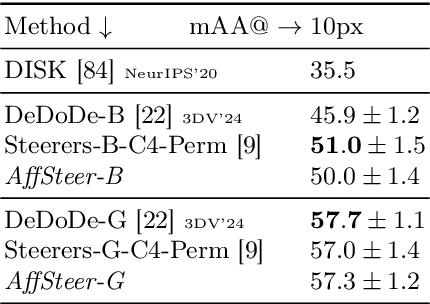
Abstract:We propose a way to train deep learning based keypoint descriptors that makes them approximately equivariant for locally affine transformations of the image plane. The main idea is to use the representation theory of GL(2) to generalize the recently introduced concept of steerers from rotations to affine transformations. Affine steerers give high control over how keypoint descriptions transform under image transformations. We demonstrate the potential of using this control for image matching. Finally, we propose a way to finetune keypoint descriptors with a set of steerers on upright images and obtain state-of-the-art results on several standard benchmarks. Code will be published at github.com/georg-bn/affine-steerers.
 Add to Chrome
Add to Chrome Add to Firefox
Add to Firefox Add to Edge
Add to Edge